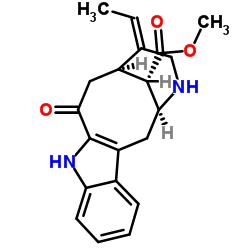2673-40-7
| Name | Perivine |
|---|---|
| Synonyms |
3-oxo-22-nor-vobasan-17-oic acid methyl ester
X1201 Methyl (1S,14R,15E,18S)-15-ethylidene-12-oxo-10,17-diazatetracyclo[12.3.1.0.0]octadeca-3(11),4,6,8-tetraene-18-carboxylate Methyl (1S,14R,15E)-15-ethylidene-12-oxo-10,17-diazatetracyclo[12.3.1.0.0]octadeca-3(11),4,6,8-tetraene-18-carboxylate Vobasan-17-oic acid,4-demethyl-3-oxo-,methyl ester Perivin 3-Oxo-22-nor-vobasan-17-saeure-methylester |
| Description | Perivine (Perivin) targets protein retinoblastoma-associated proteins (RbAp48) and resolves the instability of the RbAp48-FOG-1 complex. Perivine can be used for the study of Alzheimer's disease[1]. |
|---|---|
| Related Catalog | |
| Target |
IC50: Retinoblastoma-associated proteins (RbAp48)[1] |
| In Vitro | Retinoblastoma-associated proteins (RbAp48) are related to Alzheimer's disease (AD), RbAp48 forms a complex with the peptide FOG-1 (friend of GATA-1) and has a role in gene transcription. However, this is an unstable complex may affect the function of RbAp48. Perivine has a greater stable affinity for RbAp48 binding than FOG1, it might resolve the instability of the RbAp48-FOG1 complex and thus be used in AD therapy[1]. |
| References |
| Density | 1.3±0.1 g/cm3 |
|---|---|
| Boiling Point | 541.1±50.0 °C at 760 mmHg |
| Melting Point | 180-181ºC |
| Molecular Formula | C20H22N2O3 |
| Molecular Weight | 338.400 |
| Flash Point | 281.0±30.1 °C |
| Exact Mass | 338.163055 |
| PSA | 71.19000 |
| LogP | 3.53 |
| Vapour Pressure | 0.0±1.4 mmHg at 25°C |
| Index of Refraction | 1.652 |
CHEMICAL IDENTIFICATION
HEALTH HAZARD DATAACUTE TOXICITY DATA
|
| Hazard Codes | Xi |
|---|
